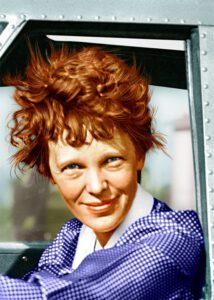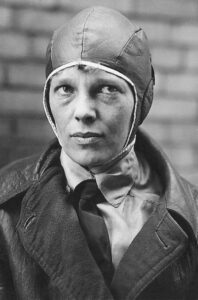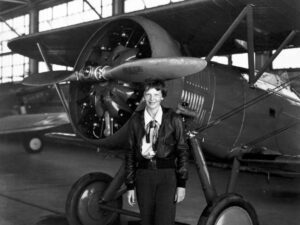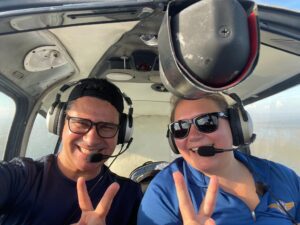 Amelia Earhart, the skybound trailblazer and her love for the sky began as a flicker, a tiny flame that grew into an insatiable passion. Born in 1897, she was a woman of extraordinary determination and courage, determined to defy the constraints of her era and make her mark in the world of aviation.
Amelia Earhart, the skybound trailblazer and her love for the sky began as a flicker, a tiny flame that grew into an insatiable passion. Born in 1897, she was a woman of extraordinary determination and courage, determined to defy the constraints of her era and make her mark in the world of aviation.
It All Starts With Flying Lessons For The Skybound Trailblazer
Amelia’s active flying career began in the early 1920s when she took her first plane ride. The moment the aircraft left the ground, she felt an exhilaration like never before, a sensation that whispered to her soul that this was where she truly belonged. With unyielding conviction, she resolved to become a pilot herself. In 1921, Amelia began taking flying lessons at Kinner Field near Long Beach, California. She embraced every aspect of aviation, from understanding the mechanics of the plane to mastering the art of navigation. Despite the challenges and skepticism she faced as a woman in a male-dominated field, Amelia’s determination never wavered.
 The Call That Changes The Course Of Her Life
The Call That Changes The Course Of Her Life
In 1928, she received a call that would change the course of her life. Famed publisher George Palmer Putnam was organizing a transatlantic flight and was looking for a woman to become the first to cross the Atlantic by air. Amelia’s name was brought to his attention, and after a thorough evaluation of her skills, he chose her to be part of the historic flight as a passenger. On June 17, 1928, she embarked on the journey aboard the “Friendship,” making history as the first woman to cross the Atlantic by air.
The Records Start To Add Up
Amelia’s thirst for adventure didn’t end there. In 1932, she set her sights on a solo transatlantic flight, hoping to follow in Charles Lindbergh’s footsteps. On May 20, 1932, Amelia took off from Harbor Grace, Newfoundland, and 14 hours and 56 minutes later, she touched down in a pasture in Northern Ireland. Her daring achievement cemented her status as an aviation icon, and she became the first woman to fly solo across the Atlantic Ocean.
But Amelia wasn’t content with just one record. In 1935, she set out on an ambitious journey to become the first person to fly solo from Hawaii to California. Battling treacherous weather conditions and technical issues, she managed to complete the 2,408-mile flight in just over 18 hours. Her tenacity and courage captured the world’s imagination once again.
Amelia’s active flying career was marked by her unrelenting pursuit of the skies and her constant desire to push the boundaries of what was considered possible. Her accomplishments weren’t just about breaking records; they were about breaking barriers for women in aviation and beyond.
Tragically, Amelia’s remarkable journey was cut short in 1937 when she disappeared over the Pacific Ocean during an attempt to circumnavigate the globe. Despite her untimely disappearance, Amelia Earhart’s legacy as a trailblazer, a symbol of courage, and a pioneer in aviation continues to inspire generations of dreamers and adventurers, reminding us all that with passion and determination, the sky is never the limit. That’s a wrap for this week, so for now Be Social, Fly Private!

 The Call That Changes The Course Of Her Life
The Call That Changes The Course Of Her Life
 Amelia Earhart: The Trailblazer of Female Aviation: When we think about pioneers in aviation, names like the Wright brothers or Charles Lindbergh might immediately come to mind. But, soaring alongside them in the annals of aviation history is Amelia Earhart, an icon who not only defied the gravitational pull of the Earth but also the societal expectations of her time. Beyond her tangible accomplishments, Earhart’s legacy is marked by her undying spirit, determination, and her influence on women in aviation.
Amelia Earhart: The Trailblazer of Female Aviation: When we think about pioneers in aviation, names like the Wright brothers or Charles Lindbergh might immediately come to mind. But, soaring alongside them in the annals of aviation history is Amelia Earhart, an icon who not only defied the gravitational pull of the Earth but also the societal expectations of her time. Beyond her tangible accomplishments, Earhart’s legacy is marked by her undying spirit, determination, and her influence on women in aviation.
